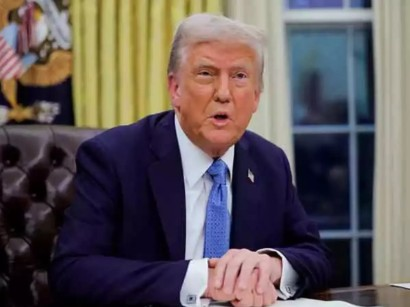April 5, 2025 — Leading global economists and brokerages are warning that the U.S. economy is on the brink of a recession, triggered by the sweeping reciprocal tariffs announced by former President Donald Trump. As the trade war escalates, the economic outlook for the world’s largest economy has darkened considerably.
In a sobering revision, JPMorgan Chase & Co. now forecasts U.S. real GDP to shrink by 0.3% for the year (measured Q4/Q4), slashing its previous projection of 1.3% growth. Michael Feroli, the bank’s chief U.S. economist, said the contraction is expected to weaken hiring and push the unemployment rate to 5.3%, up from its current 4.2%.
“We now expect real GDP to contract under the weight of the tariffs,” Feroli wrote in a note to clients. “If realised, our stagflationary forecast would present a dilemma to Fed policymakers.” Feroli expects the U.S. Federal Reserve to respond by initiating a series of rate cuts starting in June, continuing through each meeting until January 2026.
Other global banks are also slashing their outlooks. Citigroup has trimmed its growth forecast for the year to 0.1%, while UBS reduced its projection to 0.4%.
Jonathan Pingle, UBS’s Chief U.S. Economist, anticipates a steep drop in imports—over 20%—over the next few quarters. “This will push imports as a share of GDP back to pre-1986 levels,” Pingle noted. “The forcefulness of the trade policy action implies substantial macroeconomic adjustment for a $30 trillion economy.”
Markets have already begun to react sharply. In a brutal two-day selloff, the Dow Jones Industrial Average plunged over 2,000 points, the S&P 500 recorded its worst decline since the pandemic-led crash of March 2020, and the Nasdaq slipped into bear market territory, down more than 20% from its recent highs.
Despite the growing alarm among economists, Federal Reserve Chair Jerome Powell struck a cautious tone Friday, saying “it feels like we don’t need to be in a hurry” regarding rate adjustments. His comments followed March’s jobs report, which showed solid hiring but a slight rise in the unemployment rate to 4.2%.
The Trump administration’s tariff strategy, aimed at mirroring duties imposed by trading partners, is part of a broader effort to reset global trade terms. But critics warn the policy risks backfiring, shrinking U.S. trade volumes and weakening consumer spending just as inflation pressures persist.
With Wall Street reeling, central bankers divided, and recession risks rising, all eyes will now be on the Fed’s June meeting—and how deep the impact of the tariffs will go.


